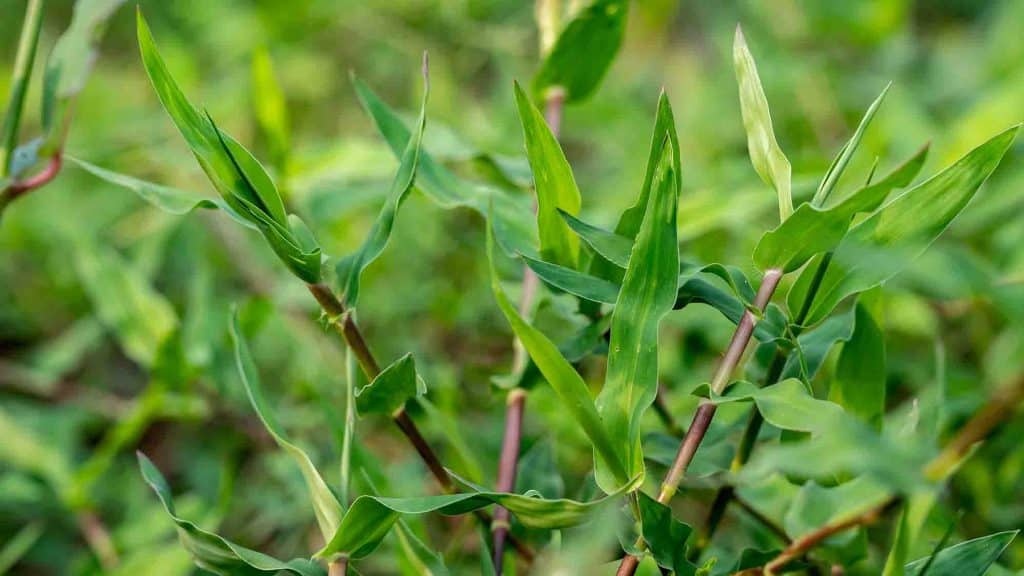Barnyardgrass (Echinochloa crusgalli) is an annual grass weed most commonly found in newly established turf. Barnyardgrass tends to be more prevalent when soil is newly seeded in the hot summer months. As a nuisance weed, it grows faster than the desirable turf grasses that usually need cooler temperatures to germinate. Barnyardgrass can spread quickly and overtake your lawn, stealing nutrients from healthy turfgrass.
While coarse barnyardgrass will be killed by the first frost in autumn, it can be a big problem in your lawn for a whole season, setting back any hope for that coveted lush green lawn you envisioned. By understanding and recognizing this pesky weed, you can better understand how to get rid of it once and for all.
Identifying Barnyardgrass

Barnyardgrass is a common weed that also looks similar to other common weeds, such as crabgrass. It’s important to identify barnyardgrass to combat it successfully.
To identify barnyardgrass, look for these traits:
- Leaf blades: The leaf blades are flat, coarse, and smooth. They are typically 2-6 inches long and ¼-½ inch wide. The midvein is prominent.
- Leaf-sheath: The leaf sheath is open and flattened. It is often maroon-tinged at the base.
- Flowers: The flowers are small and green. They are arranged in a panicle, which is a loose, branching cluster.
- Seeds: The seeds are brown or tan and oval-shaped. They are about 1/16 inch long.
Lifecycle Of Barnyardgrass

Barnyardgrass is a summer annual, meaning it completes its lifecycle in one year. The seeds can remain viable in the soil for up to 13 years so barnyardgrass can be a persistent weed.
- Germination: Barnyardgrass seeds germinate in the spring, when soil temperatures reach 55-65 degrees Fahrenheit.
- Vegetative growth: The plant grows rapidly during the spring and summer, reaching heights of up to 6 feet.
- Flowering: Barnyardgrass flowers from July to September. The flowers are small and green and arranged in a panicle.
- Seed production: Barnyardgrass is a prolific seed producer, and each plant can produce up to 40,000 seeds. The seeds mature in late summer or early fall.
- Seed dispersal: The seeds are dispersed by wind, water, and animals.
Controlling Barnyardgrass

Barnyardgrass is a common weed that can be difficult to control. However, there are a number of methods that can be used to reduce its spread and impact.
Here are some tips on how to control and prevent barnyardgrass:
- Hand-pulling: This is the most effective way to control barnyardgrass in small areas. Be sure to remove the entire plant, including the roots.
- Mowing: Mowing can help to control barnyardgrass, but more is needed. The seeds can remain viable in the soil for up to 13 years.
- Herbicides: There are several herbicides that can be used to control barnyardgrass. Be sure to follow the label directions carefully.
- Water management: Barnyardgrass prefers moist soil, so reducing water levels can help to prevent its growth.
- Soil aeration: Aerating the soil can help to improve drainage and reduce the likelihood of barnyardgrass growth.
- Cover crops: Planting cover crops can help to suppress barnyardgrass growth.
- Rotational cropping: Rotating crops can help to reduce the build-up of barnyardgrass seeds in the soil.
It is important to note that there are many methods that will completely control barnyardgrass. A combination of methods is often necessary to achieve effective control.
Here are some additional tips for preventing barnyardgrass:
- Remove weeds from infested areas: This will help reduce the number of seeds available to germinate.
- Clean up debris: Debris can harbor barnyardgrass seeds, so it is important to clean up debris from around your property.
- Avoid overwatering: Overwatering can create conditions that are favorable for barnyardgrass growth.
- Plant-resistant varieties: Several varieties of turfgrass and other plants are resistant to barnyardgrass, such as Bermudagrass.
By following these tips, you can help to control and prevent barnyardgrass in your yard or garden.
